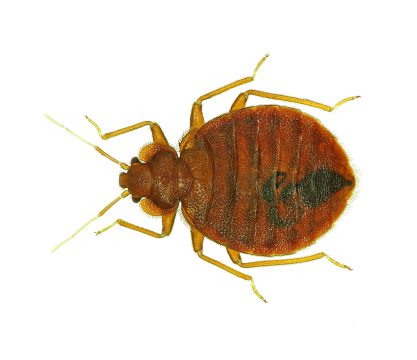
Sleep tight – don’t let the bedbugs bite! –While many of us would have heard this phrase as our parents put us to bed – how much do you know about bed bugs?
If you’re waking up to itchy, red bites or noticing small, reddish-brown insects after a night’s sleep, you may be facing an unwelcome infestation of bed bugs. These tiny, elusive pests are experts at hiding and can be found in mattresses, bed frames, and even in tiny cracks in the wall, making them a challenging adversary for those staying at hotel or even in their own home. Bed bugs feed on human blood, usually at night, leading to sleepless nights and discomfort for those affected. We understand the urgency and distress that a bed bug infestation can cause. Here, you’ll find comprehensive information on identifying, preventing, and effectively eliminating bed bugs from your home or premises, ensuring peace of mind and a return to comfortable, bite-free nights.
Bedbugs are incredibly hard to find, and excellent at finding a nook or cranny to hide in.
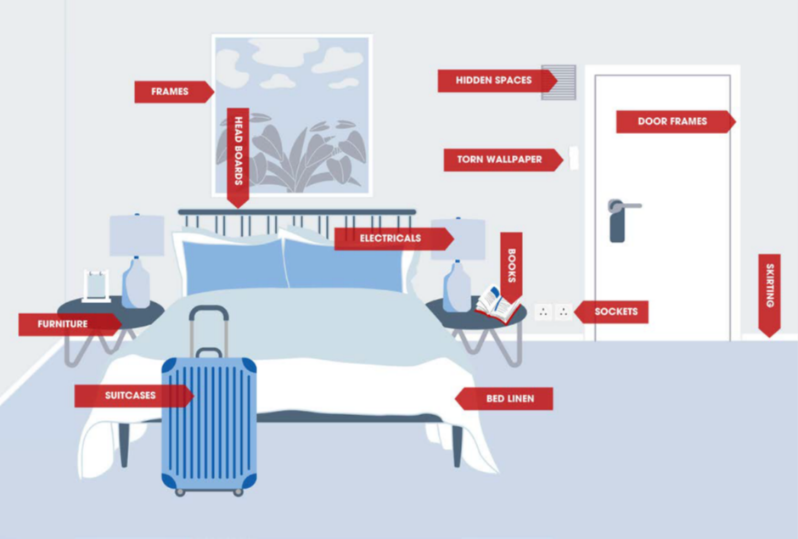
Unfortunately, where it come to treating a bed bug infestation, they are incredible hardy: surviving in scorching desert heat, up to 45°C degrees, and chilly winter temperatures, as low as -8°C which is why sprays etc are generally ineffective. Identifying the issues as soon as possible in key to ensuring an infestation does not take hold.
What are Bed Bugs?
Like mosquitos, when bed bugs bite, they very kindly anesthetise the area they plan to feed on. They primarily come out at night to feed, hiding during the day and track the CO2 coming from our breath to find someone to feed on even in pitch darkness. For many people there will be no reaction to a bite which normally occurs on areas of exposed skin, especially areas not covered by a sheets or blanket, such as arms, legs, feet, face or neck. Should you have a reaction the area will be reddish, raised, and itchy, like a flea or mosquito bite, there may be no discernible pattern. Treatment of bed bug bites requires removing the affected person away from possible exposure and use of antihistamines and/or steroids.
An adult bed bug is round and the length and width of an apple seed. Although they are they are unable to fly they do have small front wings, but no hind wings and move like ants like movements, , but no hind wings. Sometimes hey can be mistaken for other insects, such as booklice, small cockroaches, or carpet beetles.
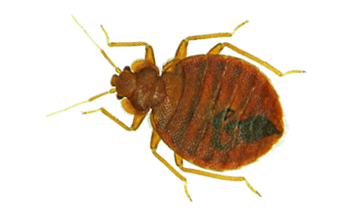
While a female bed bug generally lays one egg per day, looking as innocuous looking as a grain of sand, if conditions are right, she can lay up to seven eggs daily. Newly hatched nymphs are translucent, becoming browner as they moult and reach maturity. During each stage of growth, they need a blood meal to move to the next stage of maturity and shed their skins through ecdysis at each stage. When hungry they are quite flat, oval-shaped and brown in colour however a feed leaves them longer, plump and reddish-brown and while they can go for months without feeding, they do to feed on blood for survival as well as their development and will actively travel to source a blood source – us!
Which is why you should regularly check your mattress for signs of activity.
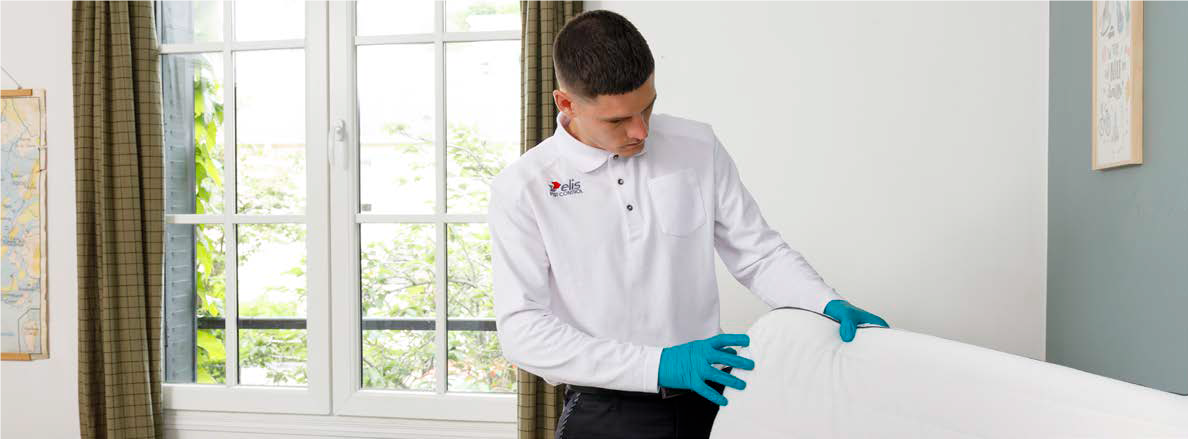
Bed Bugs in Hotels / Hostelries
As international travel has increased, so too has the incidences of bed bugs in Irish hotels. While no reflection on the cleanliness of a premises, the reputational and physical damage of a bed bug infestation can be devasting. It is estimated that a 200-room hotel could suffer losses of €65,000 per year* should they suffer from a bed bug incident. And with four out of five hotels dealing with an incident of bed bugs each year the threat is real.
Averaging the size of an apple seed, bedbugs hide in the cracks and crevices of beds, box springs, headboards, bed frames, skirting boards etc. coming out at night to feed on your guests as they sleep. Difficult to detect, inspection takes time your housekeeping staff do not have.
*Max Malka, Dec 2021, based on a 200 room hotel – www.hospitality.net
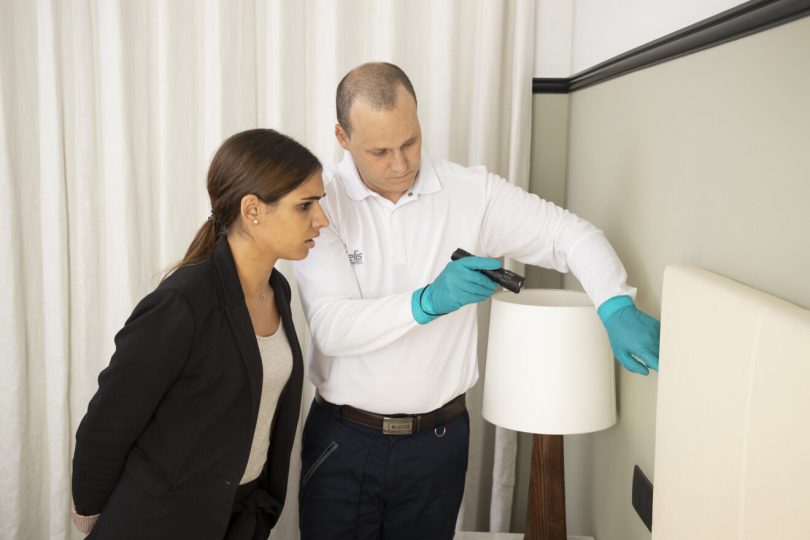
How do we treat Bed Bugs?
Commercial
For commercial premises we would advise that prevention is better than cure – at Elis Pest Control we have developed a 24/7 monitoring system with live alerts which means as soon as there is bed bug activity our team is aware of the issue and will contact you to advise on next steps.
An incidence of bedbugs can be a costly, and can destroy the reputation of a hotel.
- Time and energy must be spent dealing with this damaging issue by your management team
- Loss in revenue as your rooms undergo treatment
- Loss in potential earnings due to reputational damage
- Loss in productivity by your housekeeping team
- Cost of replacement fixtures after an infestation
- Cost of compensation to affected customers
ELIS CONNECT
Our bed bug monitoring units are wireless, discreetly fitting beneath a mattress. Our technicians fit units within minutes providing LIVE alerts of activity. 24/7 monitoring ensures our sensors will record activity as it occurs, allowing for early detection that ensures an infestation is contained, preventing spread to other rooms. Once activity is noted our expertElis technicians will be onsite, to advise on the best treatment strategy for your premises.
To view the system and how it works – https://youtu.be/_lxmph0ZlEA
In the case of an infestation
At Elis we use Heat treatments for bed bug infestation, applying high temperatures to exterminate the insects and their eggs. This approach is considered one of the most effective ways to eliminate bed bugs in all their life stages: eggs, nymphs, and adults and has the added benefit of being chemical free.
How It Works
Insects like humans are made up of proteins and when a cell is heated up to around 45°C or more its DNA starts to break down and so the cell ceases to function. To successfully deal with a bed bug infestation all items within the room will be brought inside our specially designed heat tents and to a temperature of 50°C for approximately 2 hours. Our technicians will review the process remotely and so, if required, can be dealing with other issues on site while the heat treatment is in process..
We can also seal the affected room or area to prevent bed bugs from escaping and then gradually increase the temperature to the target range. The heat penetrates into cracks, crevices, and fabric folds where bed bugs hide, ensuring that no spots are missed.
Benefits
Effectiveness: Heat treatment can eliminate bed bugs in all life stages in one go, reducing the need for repeat treatments. This method does not involve the use of chemical pesticides, making it a safer alternative for people with sensitivities or concerns about pesticide exposure and means that rooms can be available to you withing a few hours.
Domestic
The key to efficient treatment of bed bugs is preparation, we would ask that you, the homeowners / tenant prepare the infested area according to our instructions to ensure that no personal items that may be heat-sensitive items. Out technicians are highly trained in this area and also perform regular refresher course and are there to advise you. Heat treatments are a highly effective and environmentally friendly way to eliminate bed bug infestations.
To speak to one of our experts – Click Here
How to avoid bringing bed bugs into your home
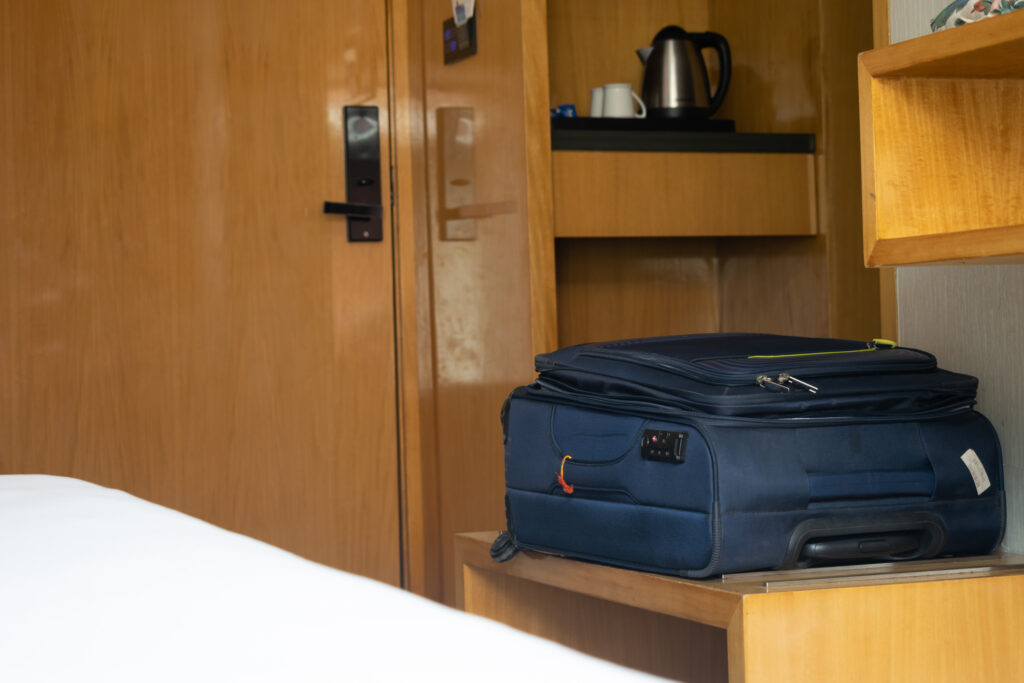
Should you identify a bed bug issue in your home – chances are that you or a guest has inadvertently brought them home after a trip abroad.
To avoid these unwanted guests here are some tips:
- Inspect your accommodation: As soon as you arrive inspect your room – BEFORE you unpack, check : the mattress, bed frame, headboard, and nearby furniture (like sofas and chairs) for any signs of bed bugs. You are looking for small, brown insects, reddish stains, tiny white eggs, or dark spots that could be their droppings.
- Use luggage racks: Instead of placing your luggage on the bed, floor, or furniture, use a luggage rack. Inspect the rack first for signs of bed bugs. Placing your luggage on a luggage rack away from the walls and bed can help minimise the risk of bed bugs crawling into your belongings.
- Keep your luggage zipped closed whenever you’re not using it.
- Use plastic bags to seal your luggage and belongings. This adds an extra layer of protection against bed bugs.
- Avoid placing clothes on beds or furniture: use hangers or hooks to keep your clothing away from potential bed bug hiding spots.
- MOST IMPORTANT – Inspect your belongings before re-packing – pay special attention to the seams of your luggage and any folds in your clothing.
- Once you get home – launder your clothes in hot water and dry them on the highest heat setting possible. Heat is effective at killing bed bugs and their eggs.
- Hoover our suitcase and any bags you travelled with to remove any potential bed bugs and then be sure to dispose of the vacuum cleaner bag or clean the vacuum’s canister outside to avoid bringing any bed bugs inside.
- Be vigilant – keep an eye out for any signs of bed bugs in the weeks following your travel, remember bed bugs are not a reflection of cleanliness but early detection is key to preventing a full-blown infestation.
- Should you discover bed bugs – call the experts to ensure an efficient and effective riddance program.
